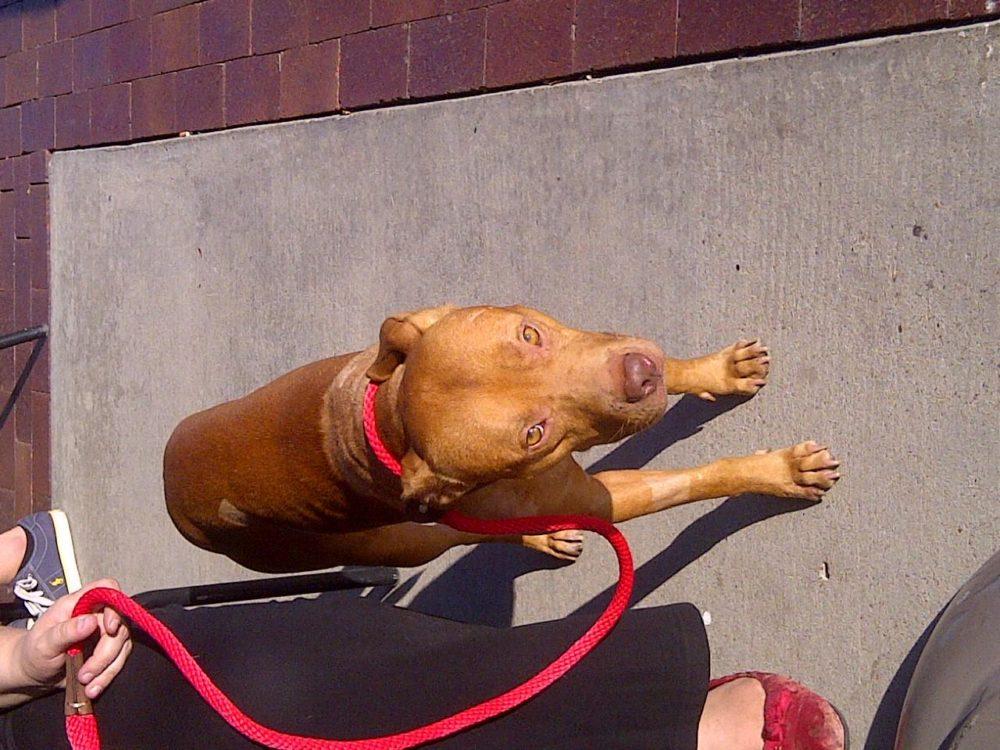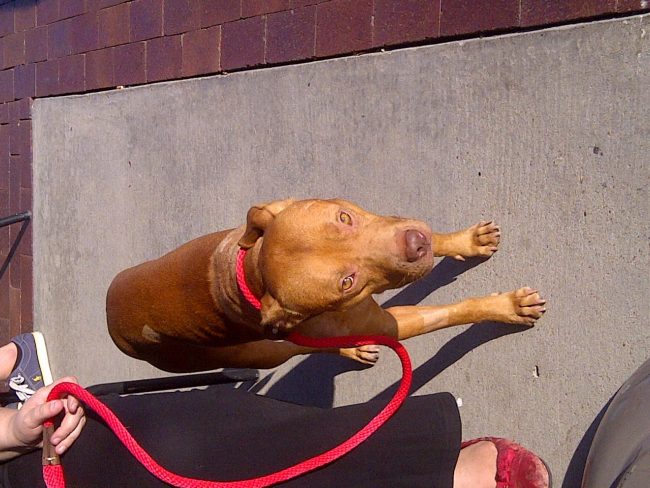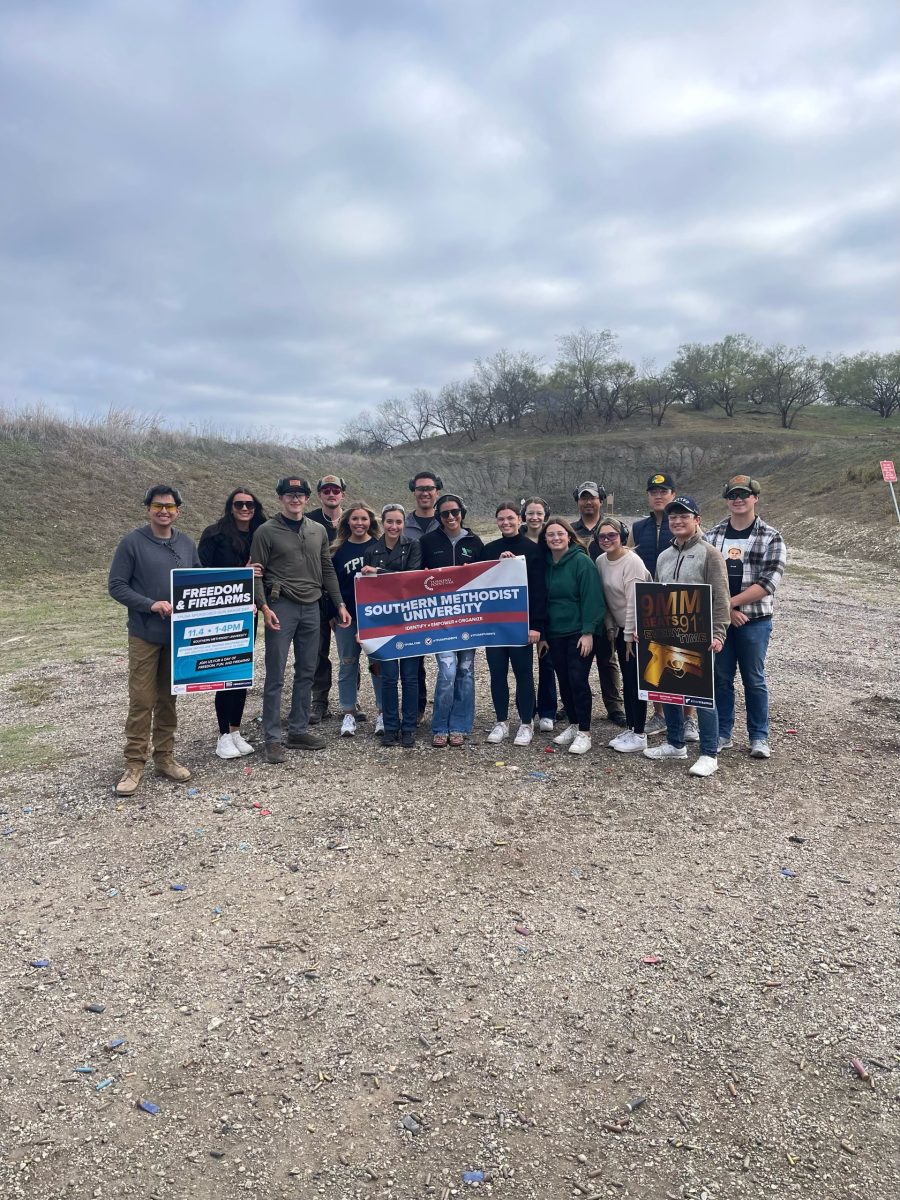
Chance was rescued in critical condition on Sept. 19 by Duck Team 6, a nonprofit rescue group, and he is looking for a forever home. His story, among stories of other rescued dogs, can be found on Duck Team 6’s Facebook page. (Leila Mustafa)
Ebony advocates for street dogs and currently works for Dallas CPR and First Aid. She also has roughly 270 likes on her Facebook page.
Ebony is a Pit Bull-American Bulldog mix. Homeless people fed her after her owners dumped her in South Dallas six to eight months ago and drove away. When she was found, she was covered in so many fleas they appeared as black patches.
Ebony ended up being fostered, and later adopted into a forever home. Her Facebook, titled “Ebony the Enduring,” serves as one of many examples of using social media to advocate for fostering, adoption and rescue of stray dogs. Ebony’s story touched many Facebook users, and now her page is used to share pictures and information about dogs in the Dallas area that need homes.
“When people’s hearts get drawn into a story, that’s how you find a foster or adopter,” Beth Bowers, Ebony’s owner and foster coordinator for Duck Team 6, a local nonprofit dog rescue organization, said.
Rescue groups, individuals, animal shelters and many more are using the Web using sites such as petfinder.com to find fosters and adopters while also utilizing the technology to spread information about the causes of dog overpopulation. Like other businesses, the animal rescue community is relying even more heavily on social media sites like Facebook, Twitter and YouTube.
“With this page [Help & Rescue Animals Facebook page] we can reach people all over the world, we can educate people [and] we can find homes for animals,” McKenzie Yager, a social media user from Corsicana, said.
The stories used on the pictures and blurbs on sites such as Yager’s often grab the hearts of those scanning the Web.
There is an overpopulation of stray dogs nationwide, including in Dallas. The Oxford Lafayette Humane Society estimates that there are 70 million stray dogs and cats living in the U.S., and 6 to 8 million dogs and cats are brought into shelters each year. Dallas rescue group Duck Team 6 estimates that here are higher concentrations in Oak Cliff, East Dallas and Pleasant Grove according to JP Bonnelly, the group’s president.
Causes include lack of neutering and spaying and puppy mills that decrease adoption of dogs from overpopulated shelters. Owner abandonment is a factor as well, as some owners can no longer afford the animals and drop them off at shelters, while others leave the dogs on roadsides.
Bowers fostered her dog Ebony after Duck Team 6 captured her. She wasn’t present when her co-ducks found Ebony, but the dog’s story and her “sad” picture on Facebook spoke to her. Bowers resfers to her as a “foster failure” since she ended up loving Ebony enough to adopt her.
“[With] her pictures and her stories…that’s it. I was a goner,” Bowers said.
Ebony is not only in a forever home, but is also a demo dog for Dallas CPR & First Aid and an advocate for Pit Bulls and stray dogs. Ebony lives with two Basset Hounds, a Siberian Husky and whoever Bowers’ “foster of the week” happens to be.
Social media isn’t only utilized to attract potential fosters and adopters, although that trend is becoming increasingly common. Yager has a Facebook page titled “Help & Rescue Animals” that serves to educate on ways to reduce dog overpopulation in addition to advocating for fosters and adopters. She believes the stray problem in her town is “completely out of control.”
“You cannot drive through our town without spotting multiple dogs or cats running in the streets,” Yager said.
Yager also shares pictures of dogs that need fostering that reside within an hour and a half of Corsicana with the page’s fans, which may soon amount to 200.
Just like Yager, Duck Team 6 uses the Web to reach out to its 2,000 and counting fan base. Duck Team 6 not only has fans in the Dallas area, but also fans overseas and in states such as Florida and California.
The organization’s Facebook page posts “Look who got caught!” updates when the group rescues a stray. While the group also has a Twitter, Facebook and YouTube are the main social media tools the team uses.
Since Duck Team 6 consists of only 12 people, the group’s efforts focus primarily on rescue, not fostering. That is where social media comes in: helping locate fosters for the dogs that are caught. Often, the stories and videos posted develop a fan base that can result in a foster before the dog is rescued. The Facebook page also allows the group to accept donations for veterinary care, boarding expenses and equipment.
Many speculate that pets may be abandoned because owners can no longer afford them and that that is the main reason for the overpopulation of dogs. Bonnelly said the main reason dogs become strays is probably irresponsible owners and ignorance, possible because many owners don’t spay and neuter their pets.
“Some just don’t care,” Bonnelly said.
Refusing to spay and neuter pets is actually illegal for most pet owners in Dallas. As of Oct. 25, 2008, all dogs and cats in the city of Dallas are required to be neutered and spayed unless they obtain an intact animal permit, or fall under the exceptions, such as being under 6 months of age or for health reasons.
Dallas Animal Services has partnered with Big Fix for Big D and offers $20 spaying, neutering and vaccination services for several South Dallas zip codes. However, there are still many owners who have not spayed or neutered their pets. To see what zip codes qualify, visit www.bigfixforbigd.com
Sandra Mustafa, director of Dog & Kitty City, a Dallas animal shelter, agrees that the lack of spaying and neutering largely contributes to the overpopulation problem.
Dog & Kitty City, a no-kill shelter, does not typically take in strays because of limited space. Mustafa said that the shelter typically has to redirect people to animal control centers two to three times a week. Still, the shelter often finds dogs dumped more often than it would like. Mustafa recently found three puppies on the rails of a DART railroad track.
“It’s a really frustrating situation. They were going to be hit by a train,” she said.
Although Dog & Kitty does use Facebook, social media is not what it relies on primarily. Its website, dogandkittycity.com, is mainly what the shelter uses to find fosters and adopters, as well as those who visit the shelter in person. The shelter’s website, http://www.dognkittycity.org, includes a Webcam where visitors can see the pets before going to the shelter.
Bonnelly believes another large contributor to the overpopulation is store-purchased puppies. About 90 percent of puppies are estimated to come from puppy mills, according to paws.org. Puppy mills are often thought of as mass-producing, commercial dog breeding centers operated with an emphasis on profits, and with less of an emphasis on the best interests of the dogs. According to the American Society for the Prevention of Cruelty to Animals (ASPCA), only 20 to 30 percent of dogs are adopted from shelters and homes.
“If we can educate the public and crack down on the people trying to turn dogs and cats into cash crops we can begin to make a dent in the stray population,” Yager said.
Whether it seeks to educate the public or attract dog lovers, social media provides animal advocates with tools to help address the overpopulation of dogs, both in Dallas and worldwide.
https://www.facebook.com/DuckTeam6
https://smudailycampus.com/news/metropolitan









